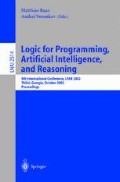Abstract
A Boolean formula is unsatisfiable if and only if its representing binary decision diagram (BDD) is reduced to the single leaf “false”. When BDD variables represent first-order atoms including equalities between terms, uninterpreted predicates or linear arithmetic constraints, a path to the “true” leaf in the BDD might not give a model. So BDDs representing unsatisfiable quantifier-free first-order logic formulas may not reduce to the single leaf “false”. Decision procedures for combinations of theories can be used to eliminate all those unsatisfiable paths. In a naive approach every path would be considered; this would be very inefficient. We provide efficient algorithms to find general constraints (connections) from unsatisfiable paths to “true” in the BDD. Adding those connections to the BDD will eliminate many paths to “true” at one go. This procedure also ensures that no unnecessary constraint is added.
In the context of invariant validation, this gives good results when using BDDs with a rich quantifier-free language.
This work was partially funded by a grant of the “Communauté française de Belgique -Direction de la recherche scientifique - Actions de recherche concertées”.
Access this chapter
Tax calculation will be finalised at checkout
Purchases are for personal use only
Preview
Unable to display preview. Download preview PDF.
References
W. Ackermann. Solvable Cases of the Decision Problem. Studies in Logic and the Foundations of Mathematics. North-Holland, Amsterdam, 1954.
C. W. Barrett, D. L. Dill, and A. Stump. A generalization of Shostak’s method for combining decision procedures. In Frontiers of Combining Systems (FROCOS), volume 2309 of Lecture Notes in Computer Science. Springer-Verlag, 2002.
N. S. Bjørner, Z. Manna, H. B. Sipma, and T. E. Uribe. Deductive verification of real-time systems using STeP. TCS: Theoretical Computer Science, 253, 2001.
R. E. Bryant. Graph-based algorithms for boolean function manipulation. IEEE Transactions on Computers, 35(8):677–691, Aug. 1986.
W. Chan, R. Anderson, P. Beame, and D. Notkin. Combining constraint solving and symbolic model checking for a class of systems with non-linear constraints. In Proc. 9th Conf. Computer Aided Verification, volume 1254 of Lecture Notes in Computer Science, pages 316–327. Springer-Verlag, 1997.
K. M. Chandy and J. Misra. Parallel Program Design. Addison-Wesley, Reading, Massachusetts, 1988.
D. Cyrluk, P. Lincoln, and N. Shankar. On Shostak’s decision procedure for combinations of theories. In Proc. 13th Int. Conf. on Automated Deduction, volume 1104 of Lecture Notes in Computer Science, pages 463–477, New Brunswick, NJ, 1996. Springer-Verlag.
J.-C. Filliâtre, S. Owre, H. Rueß, and N. Shankar. ICS: integrated canonizer and solver. In Proc. 13th Conf. Computer Aided Verification, volume 2102 of Lecture Notes in Computer Science, pages 246–249. Springer-Verlag, 2001.
A. Goel, K. Sajid, H. Zhou, A. Aziz, and V. Singhal. BDD based procedures for a theory of equality with uninterpreted functions. In Proc. 10th Conf. Computer Aided Verification, volume 1427 of Lecture Notes in Computer Science, pages 244–255. Springer-Verlag, 1998.
J. Goubault. Proving with BDDs and control of information. In Proc. 12th Conf. on Automated Deduction, volume 814 of Lecture Notes in Computer Science, pages 499–513. Springer-Verlag, 1994.
E. P. Gribomont and D. Rossetto. CAVEAT: technique and tool for Computer Aided VErification And Transformation. In Proc. 7th Conf. on Computer Aided Verification, volume 939 of Lecture Notes in Computer Science, pages 70–83, Liege, Belgium, 1995. Springer-Verlag.
E. P. Gribomont and N. Salloum. Using OBDD’s for the validation of Skolem verification conditions. In Proc. 16th Int. Conf. on Automated Deduction, volume 1632 of Lecture Notes in Computer Science, pages 222–226, Trento, Italy, 1999. Springer-Verlag.
J. F. Groote and J. van de Pol. Equational binary decision diagrams. In Logic Programming and Automated Reasoning, volume 1955 of Lecture Notes in Computer Science, pages 161–178. Springer-Verlag, 2000.
C. Heitmeyer and N. A. Lynch. The generalized railroad crossing — a case study in formal verification of real-time systems. In Proceedings 15th IEEE Real-Time Systems Symposium, San Juan, Puerto Rico, pages 120–131, Dec. 1994.
The Liège Automata-based Symbolic Handler (LASH). Available at http://www.montefiore.ulg.ac.be/~boigelot/research/lash/.
J. R. Levitt. Formal Verification Techniques for Digital Systems. PhD thesis, Stanford University, December 1998.
N. Lynch. Distributed Algorithms. Morgan Kaufmann, San Francisco, CS, 1996.
J. Møller, J. Lichtenberg, H. R. Andersen, and H. Hulgaard. Difference decision diagrams. In Computer Science Logic, volume 1683 of Lecture Notes in Computer Science, pages 111–125. Springer-Verlag, 1999.
G. Nelson and D. C. Oppen. Simplifications by cooperating decision procedures. ACM Transactions on Programming Languages and Systems, 1(2):245–257, Oct. 1979.
G. Nelson and D. C. Oppen. Fast decision procedures based on congruence closure. Journal of the ACM, 27(2):356–364, 1980.
J. Posegga and P. H. Schmitt. Automated deduction with shannon graphs. Journal of Logic and Computation, 5(6):697–729, Dec. 1995.
H. Rueß and N. Shankar. Deconstructing shostak. In Proceedings of the 16th Annual IEEE Symposium on Logic in Computer Science (LICS-01), pages 19–28, Los Alamitos, CA, 2001. IEEE Computer Society.
R. E. Shostak. Deciding combinations of theories. Journal of the ACM, 31(1):1–12, Jan. 1984.
C. Tinelli and M. T. Harandi. A new correctness proof of the Nelson-Oppen combination procedure. In F. Baader and K. U. Schulz, editors, Frontiers of Combining Systems: Proceedings of the 1st International Workshop (Munich, Germany), pages 103–120. Kluwer Academic Publishers, 1996.
P. Wolper and B. Boigelot. On the construction of automata from linear arithmetic constraints. In Proc. 6th Int. Conf. on Tools and Algorithms for the Construction and Analysis of Systems, volume 1785 of Lecture Notes in Computer Science, pages 1–19, Berlin, March 2000. Springer-Verlag.
Author information
Authors and Affiliations
Editor information
Editors and Affiliations
Rights and permissions
Copyright information
© 2002 Springer-Verlag Berlin Heidelberg
About this paper
Cite this paper
Fontaine, P., Gribomont, E.P. (2002). Using BDDs with Combinations of Theories. In: Baaz, M., Voronkov, A. (eds) Logic for Programming, Artificial Intelligence, and Reasoning. LPAR 2002. Lecture Notes in Computer Science(), vol 2514. Springer, Berlin, Heidelberg. https://doi.org/10.1007/3-540-36078-6_13
Download citation
DOI: https://doi.org/10.1007/3-540-36078-6_13
Published:
Publisher Name: Springer, Berlin, Heidelberg
Print ISBN: 978-3-540-00010-5
Online ISBN: 978-3-540-36078-0
eBook Packages: Springer Book Archive

